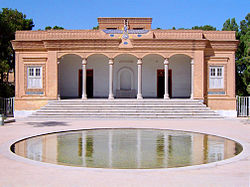
Zoroastrians in Iran have had a long history, being the oldest religious community of that nation to survive to the present-day. Prior to the Muslim Arab invasion and conquest of Persia, Zoroastrianism had been the primary religion of the Persian people. As of 1986, the Zoroastrian community in Iran was estimated to number 32,000 individuals. [1]
Background edit
Zoroastar and his first followers are believed to have been the proto-Indo-Iranians that lived between the Stone Age and Bronze Age (est. 1400-1200BC) [1]. The proto-Indo-Iranians were later devided in to two stinctive branches of Iranian and Indians; the Iranian branch slowly migrated to Iran as part of waves of migrations which had began as early as 2000 BC [2].
History edit
The dates that Iranian peoples migration to East and West of Iran are mainly estimated through the records of Assyrian records [3]. Also, Herodotus (I, 101) had recalled one of the Mede tribes to be called "Magoi", better known as "Magis", a tribe known to have included many priests not only for Medes but also for the Persians. By the time of the Median empire (est. 612 BC), Zoroastrianism is known to have been well established in both Pars region (later capital of Persia) as well as in the Eastern regions. [4]
Achaemenians edit
Persians led by Cyrus the Great soon founded and established the first Persian empire and defeated the Medes in 549BC. [5]. As Persians expanded their empire and after conquering the Asia Minor and later encountered the Greeks, Zoroastrianism was introduced to classical Greek historical records by Hermodorus Hermippus, Xanthos, Eudoxus and Aristotle who gave variety of different times to the time of Zoroastar but naturally believed him to be a Persian prophet and called him "Master of the magi" [6]
Although there are no inscriptions left from the time of Cyrus about his religion, the fire-holders found in the Pasargadae, as well as the fact that he called his daughter Atossa, name of the queen of Vishtaspa (Zoroastar's royal patron), suggests that he was indeed a Zoroastrian. [7]
Seleucids and Arsavids
Sassanid Empire edit
Caliphs edit
Later Mughol and Safavids edit
Since the revolution edit
The primary center of the Zoroastrian community in Iran is the province of Yazd. During the reign of the Pahlavi dynasty, there were increased migrations to Tehran, the nation's capital, where Zoroastrians thrived along with other religious minority groups. The Iranian Revolution of 1979 and the eventual establishment of the new theocratic Islamic Republic posed many initial setbacks for religious minorities. Today, the Zoroastrian community in Iran is estimated to number some 22,000 - half the size of that in existence before the 1979 Islamic revolution.[2]
Like the Armenian, Assyrian and Persian Jewish communities, Zoroastrians are officially recognized and on the grounds of 1906 Constitution allocated one seat in the Iranian Parliament, currently held by Kurosh Niknam.
In November 2005 Niknam was summoned before the Revolutionary Tribunal for objecting to derogatory comments made by an ultraconservative cleric, Ayatollah Ahmad Jannati, and accused of spreading false news and disrespecting authority figures. Jannati, who is a close aide to the current Supreme Leader, Ayatollah Ali Khamenei, had stated that non-Muslims "cannot be called human beings but are animals who roam the earth and engage in corruption." Niknam condemned the comments as "an unprecedented slur against religious minorities."[3]
References edit
- ^ Mary Boyce "Zoroastrians, Their Religious Beliefs and Practices" pp. 2
- ^ Stearns, Peter N. (ed.). Encyclopedia of World History (6th ed.). The Houghton Mifflin Company/Bartleby.com.
The Medes and the Persians, c.1500-559
- ^ Mary Boyce "Zoroastrians, Their Religious Beliefs and Practices" Under the Achaemenians pp. 48
- ^ Mary Boyce "Zoroastrians, Their Religious Beliefs and Practices" pp. 49
- ^ Mary Boyce "Zoroastrians, Their Religious Beliefs and Practices" pp. 49
- ^ Mary Boyce, "Zoroastrians, Their Religious Beliefs and Practices": Under the Achamenians
- ^ Mary Boyce, "Zoroastrians, Their Religious Beliefs and Practices": Under the Achamenians
See also edit
External links edit
- http://www.cais-soas.com/official_condemnation.htm Covers remarks about non-Muslim Iranians and ancient Iranians, by Islamic Republic leaders
- ^ http://www.adnki.com/index_2Level.php?cat=Religion&loid=8.0.234116648&par=0